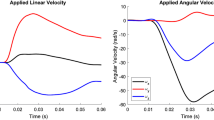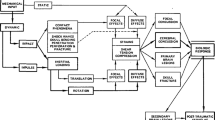Abstract
A new 3 dimensional finite element representation of the human head complex has been constructed for simulating the transient occurrences of simple pedestrian accidents. This paper describes the development, features and validation of that model. When constructing the model, emphasis was placed on element quality and ease of mesh generation. As such, a number of variations of the model were created. The model was validated against a series of cadaveric impact tests. A parametric study (a High/Low study) was performed to investigate the effect of the bulk and shear modulus of the brain and cerebrospinal fluid (CSF). The influence of different mesh densities on the models and the use of different element formulations for the skull were also investigated. It was found that the short-term shear modulus of the neural tissue had the predominant effect on intracranial frontal pressure, and on the predicted Von-Mises response. The bulk modulus of the fluid had a significant effect on the contre-coup pressure when the CSF was modelled using a coupled node definition. Differences of intracranial pressure were reported that show the sensitivity of the method by which the skull is modelled. By simulating an identical impact scenario with a range of different finite element models it has been possible to investigate the influence of model topologies. We can conclude that careful modelling of the CSF (depth/volume) and skull thickness (including cortical/trabecular ratio) is necessary if the correct intracranial pressure distribution is to be predicted, and so further forms of validation are required to improve the finite element models' injury prediction capabilities.
Similar content being viewed by others
References
Meaney, D F, Thibault, L E and Gennarelli, T A. Rotational brain injury tolerance criteria as a function of vehicle crash parameters. In Proc.of the 1994 International IRCOBI Conf.on the Biomechanics of Impacts, pages 51–62, 1994.
Trosseille, X, Chamourd, F and Tarriere, C. Reconsideration of the HIC, taking into account the skull bone condition factor (SBCF)– limit of head tolerance in side impacts. In Proc.of the 32nd Stapp Car Crash Conf, SAE paper no. 881710,1988.
Nahum, A M, Smith, R W and Ward, C C. Intracranial pressure dynamics during head impact. In Proc.of the 21st Stapp Car Crash Conf, SAE paper no. 770922,1977.
Misra, J C and Chakravarty, S. A study on rotational brain injury. ASME J. Biomech.Eng.,17:459–466,1983.
Goldsmith, W. Biomechanics of Head Injury, Biomechanics, Its Foundations and Objectives. Prentice-Hall,1972.
Gurdjian, E S. Recent advances in the study of the mechanism of impact injury of the head-a summary. Clin. Neurosurg,18:1–42,1972.
Holbourn, A H S. Mechanics of head injuries. Lancet, 2: 438–441,1943.
Ruan, J S. Impact Biomechanics of Head Injury by Mathematical Modeling. PhD thesis, Wayne State University, 1994.
Edberg, S, Rieker, J and Angrist, A. Study of impact pressure and acceleration in plastic skull models. Labs. Invest.,12:1305–1311,1963.
Kleiven, S, and Holst, H Von. Consequences of size following trauma to the human head. J.Biomechanics, 35:135–160,2002.
Willinger, R, Kopp, C M, and Cesari, D. New concept of contrecoup lesions:Modal analysis of a finite element head model. In Proc.of the 1992 International IRCOBI Conf.on the Biomechanics of Impacts, pages 283–298.
Zhou, C, Khalil, T B and King, A. Viscoelastic response of the human brain to sagittal and lateral rotational acceleration by finite element analysis. In Proc.of the 1996 International IRCOBI Conf.on the Biomechanics of Impacts, pages 35–48,1996.
Lee, E S. A Large-Strain, Transient-dynamic Analysis of Head Injury Problems by the Finite Element Method. PhD thesis, Georgia Institute of Technology,1990.
Sauren, A A H J and Claessens, M H A. Finite element modelling of head impact:The second decade. In Proc.of the 1993 International IRCOBI Conf.on the Biomechanics of Impacts, pages 241–251,1993.
National Institutes of Health (NIH) U. S. National Library of Medicine. Department of health and human services. Visible Human Database www.nlm.nih.gov/research/visible/visible human.html.
Lorenson, B. Vtk open source software. http://public.kitware.com/VTK/.
Patran r2a. MSC/Patran User 's Manual. MSC, 2002.
Claessens, M, Sauren, A A H J and Wismans, J S H M. Modeling of the human head under impact conditions:A parametric study. In 41st Stapp Car Crash Conf, SAE Paper No. 973338, Society of Automotive Engineers, pages 315–328, 1997.
Shugar, T A and Katona, M G. Development of a finite element head injury model. ASCE J.Eng.Mech.Div., EM3(E101/173): 223–239,1975.
Ward, C and Thompson, R. The development of a detailed finite element brain model. In Proc.19th Stapp Car Crash Conference. SAE Paper No.751163, 1975.
Kang, H, Willinger, R and Diaw, B M. Validation of a 3d anatomic human head model and replication of head impact in motorcycle accident by finite element modeling. In Proceedings of the 41st Stapp Car Crash Conference., pages 329–338,1997.
MATLAB 5.6. MATLAB User 's Manual. MATHWORKS, 2000.
Hosey, R R and Liu, Y K. Finite element in biomechanics. In Johnson, B R, Gallagher, T C, Simon, R H and Gross, J F. editors, A Homeomorphic Finite Element Model of the Human Head and Neck, pages 379–401. Wiley, 1982.
DiMasi, F, Marcus, J H and Eppinger, R H. 3-d anatomic brain for relating cortical strains to automobile crash loading. In Proc. 13th Int.Tech.Conference.on Experimental Safety Vehicles, Paper No.91-S8-O-11,1991.
Turquier, F, Kang, H S, Trosseille, X, Willinger, R, Lavaste, F, Tarriere, C and Domont, A. Validation study of a 3d finite element head model against experimental data. Proc.of the 40th Stapp Car Crash Conf., SAE paper no. 962431,1996.
Mendis, K K, Stalnaker, R L and Advani, S H. A constitutive relationship for large deformation finite element modeling of brain tissue. Journal of Biomechanical Engineering,117(4)q:279–285,1995.
Hu, Hao, Nayfeh, A H and Rosenberg, W S. Modeling of human brain movability during impact. In 5th International LS_DYNA Users Conference, 1998.
Gilchrist, M D and O'donoghue, D. Simulation of the development of frontal head impact injury. Computational Mechanics,26(3):229–235,2000.
Gilchrist, M D, O'donoghue, D, and Horgan, T. A two-dimensional analysis of the biomechanics of frontal and occipital head impact injuries. Int.J.Crashworthiness, 6(2):253–262,2001.
ABAQUS 5.8. ABAQUS/Standard User 's Manual. HKS, 2000.
Willinger, R, Taleb, L and Kopp, C M. Modal and temporal analysis of head mathematical models. J. Neurotrauma, Vol.12:743–754,1995.
Mertz, H J. Size, weight and biomechanical impact response requirements for adult size small female and large male dummies. In SP-782-Automotive Frontal Impacts, SAE Paper No.890756, Society of Automotive Engineers, pages 133–144,1989.
Pheasant, S. Bodyspace, Anthropometry, Ergonomics and the design of work. Taylor & Francis, 2 edition,1996.
Zhou, C, Khalil, T B and King, A I. A new model comparing impact responses of the homogeneous and inhomogeneous human brain. In 39th Stapp Car Crash Conf., Society of Automotive Engineers, pages 121137,1995.
O'Riordain, K, Thomas, P M, Phillips, J P and Gilchrist, M D. Reconstruction of real world head injury accidents resulting from falls using multibody dynamics. In International Conference on Computational Engineering & Science, paper 81,2001.
O'Riordain, K, Thomas, P M, Phillips, J P and Gilchrist, M D. Reconstruction of real world head injury accidents resulting from falls using multibody dynamics. In Press, Clinical Biomechanics.
Rights and permissions
About this article
Cite this article
Horgan, T.J., Gilchrist, M.D. The creation of three-dimensional finite element models for simulating head impact biomechanics. International Journal of Crashworthiness 8, 353–366 (2003). https://doi.org/10.1533/ijcr.2003.0243
Issue Date:
DOI: https://doi.org/10.1533/ijcr.2003.0243




